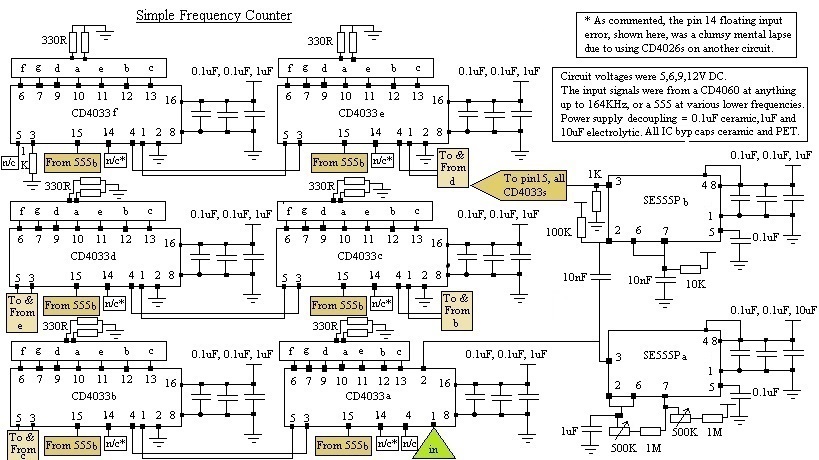Hi,
Firstly, my apologies, I'm a novice with a pretty mundane and 1970's style question about analog ICs for a very simple circuit.
I'm trying to make a simple analog frequency counter using the CD4033BE. I have made a pulse timer with the CD4026 and that circuit powers up and functions fine so far. The CD4033 frequency counter powers up terribly: some of the six LED 7-segment digits appear to be all segments on, the counter doesn't count for about thirty seconds, and then it slowly starts counting correctly but in an incremental manner until it reaches the accurate reading and then it finally continues correct Hz counting, e.g.
Power up: 0 0 8 1 8 8
30 seconds on time: 0 0 8 1 4 2
45 seconds on time: 0 0 8 0 5 8
50 seconds on time: 0 0 2 3 5 8
51 seconds on time: 0 1 4 3 5 6
(etc.)
55 seconds on time: 0 7 4 3 2 1
(etc.)
60 seconds on time: 1 6 4 7 1 7
61 etc. seconds on time: 1 6 4 7 1 7
I have only been learning about circuits for about 8 months or so, so (I lack practical experience in circuit design) am perplexed as it looks like some stupid simple problem I haven't come across before and trying a power up reset with a capacitor and a resistor on the 4033s hasn't helped (but which has always worked with the CD4017), the sequence is the same: the fourth 4033 (which counts thousands) is a stubborn "8", and the whole circuit suffers from what looks like a glitch similar to a stuck record loop, and when it finally escapes the loop it is slow to function correctly.
I have a multimeter with a frequency counter, so I know that my simple counter functions correctly once it has warmed up. The circuit is 6 4033s, with the ripple blanking function enabled, and they count for 1 second and then are clock inhibited for 1 second to hold the count by a SE555, and then they are reset by a second SE555 with a "microsecond" pulse to the reset pins. Whether the circuit runs off 5, 9 or 12 volts it exhibits this incorrect power up behaviour, and it behaves the same when counting the frequency of a device on it's own circuit or from an external circuit. Besides this problem, despite bypassing the ICs with 0.1 ceramic, 0.1 PET and 1uF PET (I'm desperately trying to avoid using aluminium electrolytic capacitors on the circuit except for the circuit power supply entry point), the supply line looks like a horrific set of jagged mountains bouncing up and down on the oscilloscope, but at least this doesn't seem to affect accurate frequency counting.
The count sequence above is just an example, but the 0 0 8 1 8 8 at the power up for thirty seconds is pretty constant.
If anyone could advise me on this problem - Is this some simple beginner mistake I'm making with the circuit power up, or am I missing something like a snubber somewhere? Many thanks.


